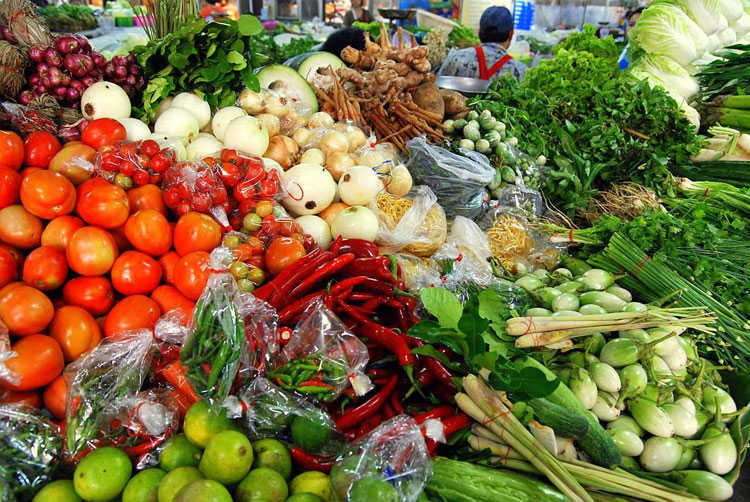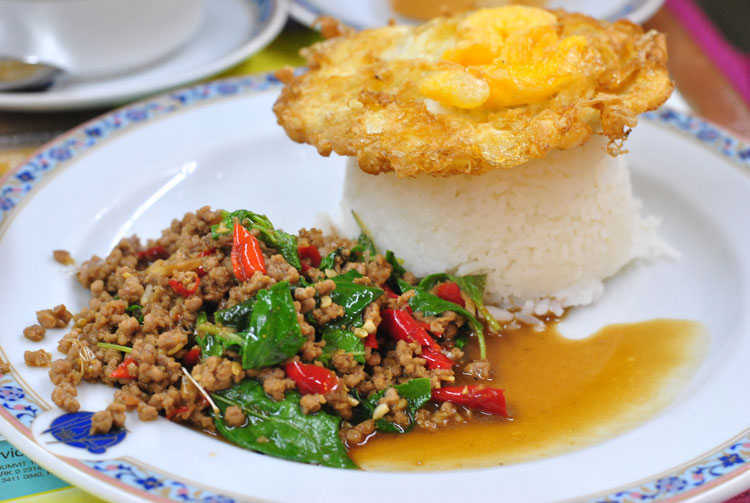Thai Food and Cuisine

Thai people love to eat. There is nothing that they enjoy more. Every corner, street and alley has a restaurant, street stall or stand selling snacks, nibbles, bites and full menus of tantalising local specialties.
Tourist restaurants will often serve up a spineless, tasteless version of what should be a full flavour feast, and without anyone to tell you the food is less than genuine; a visitor’s introduction to Thai food is often tainted by these ‘farang-ised’ Thai dishes.
Once you have had enough of yet another overly sweet, messy slop of phad thai, it is time to explore the never-ending possibilities of Thai cuisine.
When asked what they like most about Thailand, visitors often answer ‘the food’. The creation of Siam servings is a masterful mix of salty, sweet, sour, spicy and bitter.
The spice factor, often too much for most westerners, is used for medicinal purposes, combined with the use of market fresh vegetables and the choicest local herbs for bursting flavours and prevention of common ailments.
The food is low in fat and high in fiber and most dishes, considering they taste so good, are surprisingly nutritious.

But it is not only the unique and pleasantly pungent tastes that visitors love, the cost of eating in Thailand is as satisfying as the pleasure experienced by the palate. One of Thailand’s major industries is agriculture. Grains, meats, vegetables and most importantly rice are all locally produced at minimal cost.

The country also has rich waters filled with fresh and saltwater creatures, which are shipped across the land, making seafood and fish dishes some of the most popular choices. Add to this the natural innovation and long standing techniques used by Thais in food preparation and there are few who visit who cannot be satisfied.

Thai cuisine is characterised by strong spices, especially lime juice, lemon grass and fresh coriander, the combination of which gives Thai food its distinctive taste. In addition, Thai food has a reputation for being spicy (especially in the south), with hot little torpedo-shaped chilies called phrik khii nuu (lit. "mouse poo chilies") making their way into many a dish. Thais are well aware that these can be more than Westerners can handle and will often ask if you like it hot, answer "yes" at your own risk!

Thai dishes can be roughly categorized into central Thai food (around Bangkok), northern Thai food (from the northern region around Chiang Mai, with Burmese and Chinese influence), northeastern Thai food (from the Isaan region bordering with Laos) and southern Thai food (with heavy influences from Malaysia).
Thailand is the only country that eats food with a spoon and fork and soup with chopsticks 🙂 . You will catch on to this when you are in Thailand
The cost of living varies throughout Thailand and is largely governed by the amount of tourists in the area. in general a cheap basic meal of one dish and a soft drink will cost around 40 - 150 baht. In the mid range prices are approximately 150 - 300 baht.
At the top end you could pay up to 2000 baht for a 5 star seafood buffet. If you are on a tight budget roadside stalls are a good option.
Thai Simple Cookbook: Quick and easy authentic Thai recipes to make at home
All of these are authentic Thai recipes, and if you follow every step mentioned for each recipe, you will create a dish that has the same aroma and unique taste that a traditional Thai dish should have.Thai Food By Region
Passing through different regions of Thailand, you may notice that the dialect and sound of the language changes abruptly. When you think you have learned how to say sawdee kha in exactly the right tone, you move to another place and find that they have a completely different method of utterance.
The same goes for the food. There are four main regions offering cuisine adventurers a unique experience.
Food in the northeast Thailand is influenced by neighbouring Laos. Dishes are highly seasoned and among the most popular specialties are larb, a spicy, seasoned salad made with pork or chicken; somtam, spicy papaya salad, and gai yang, barbecued chicken. All are served with glutinous rice, a northern favourite widely known as sticky rice, or khao neow.

Central North & West Thailand Burmese influences have bearings on the dishes of the central northern regions. Northern cooks generally are less heavy handed with the chili and the use of ginger, tamarind and turmeric is common. Khao soi, a curry with egg noodles and pickled cabbage, is only found in the north and should be number one on any visitor’s list of dishes to try.
Tourists to the north should not miss the opportunity to dine at a traditional Khantoke dinner, combining the best of northern specialties and traditional performances in a reconstructed wooden palace.
Throughout the central plains of Thailand, the food combines mixes from all regions, and many Chinese-Thai fusions are common characteristics.
The South of Thailand is the place to get down to spicy treats. Chili-filled soups and curries are common dishes and fresh seafood is abundant. Influences are also found in dishes taken from Indonesia, such as chicken kebabs with peanut sauce (gai sate), an international favourite, and rich curries such as kaeng masaman from Malaysia.

Eating in Thailand is very much a family affair. It is often thought of as odd to see someone eating alone and most Thais will wait to the point of starvation until they find a dining partner.
A typical meal will include a soup, fried fish, spicy salad known as yam, a curry dish and a dip with vegetables. Each member of the party will be served a bowl of rice and can take a bite from the main dishes in the centre of the table. Meals are eaten with a spoon and fork, while chopsticks are generally only used for noodle soups or Chinese food.
Thai ‘fast food’ is known as such, not because of its enticing greasiness or fat content as with the western equivalent, but instead as a range of dishes that can be cooked up in a matter of minutes.
These dishes such as phad thai, or fried noodles, khao phad, or fried rice, or phad khrapao, or fried basil with pork or chicken, are commonly ordered as a quick lunch, breakfast or evening meal, and often served with a fried egg plonked on top.

Those interested in more than just sampling the food fare on offer while travelling in Thailand will be pleased to know that in any mildly touristy area you are sure to find a local cooking school. Courses include trips to local markets, ingredient preparation, cooking and best of all, an eating party after all the hard work. Thai recipes
Top 10 Thai Dishes Among Tourists
Tom yam goong: a spicy shrimp soup made with coconut milk, lemongrass, lime leaves, galangal and shallots.
Kaeng khio wan gai: green chicken curry made from green curry paste and coconut milk.
Phad thai: noodles fried with tofu, spring onions, bean sprouts and ground peanuts.
Phad khrapao: chicken, pork or prawns stir-fried with basil.
Kaeng phet pet yang: roast duck curry.
Tom kha gai: chicken in coconut soup with galangal and lemongrass.
Khao phad: boiled rice fried with meat, egg, onion, cilantro, garlic and tomatoes.
Moo/gai sate: pork/chicken kebabs served with peanut sauce.
Gai phad met mamuang: stir-fried chicken with cashew nuts.
Go To
Learn a few Thai words and phrases
info adapted from www.wikitravel.com http://creativecommons.org/licenses/by-sa/1.0/

